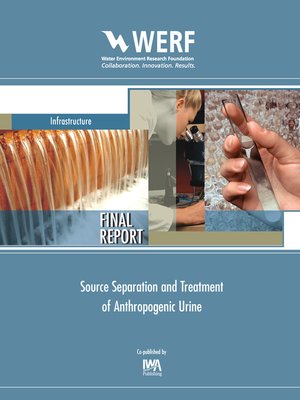Source Separation and Treatment of Anthropogenic Urine
ebook ∣ WERF Research Report
By Sybil Sharvelle

Sign up to save your library
With an OverDrive account, you can save your favorite libraries for at-a-glance information about availability. Find out more about OverDrive accounts.
Find this title in Libby, the library reading app by OverDrive.



Search for a digital library with this title
Title found at these libraries:
| Library Name | Distance |
|---|---|
| Loading... |
Available as an eBook only.
Anthropogenic urine, although only 1% of domestic wastewater flow, is responsible for 50-80% of the nutrients and a substantial portion of the pharmaceuticals and hormones present in the influent to wastewater treatment plants. Source separation and treatment of urine enables recovery of nitrogen and phosphorus, thus largely minimizing the energy requirements for nutrient removal at wastewater treatment plants, allowing for capture and reuse of nutrients, and creating a more efficient means for removal of pharmaceuticals and hormones.
The goal of this research was to investigate the global status of urine source separation and treatment technologies and to advise a path forward for further research. Results from the literature review validate urine source separation as a means to recover nutrients, conserve water, and decrease overall energy requirements for both nutrient and micropollutant removal as compared to conventional wastewater treatment. Research has matured beyond the laboratory scale to include pilot projects in office buildings, private homes, and schools. Continued research is necessary to create marketable products, to develop life cycle and/or cost-benefit analysis, to determine social acceptance in the U.S. as most surveys and projects have been conducted in Europe, and to assess the most appropriate means and setting for urine treatment.
Anthropogenic urine, although only 1% of domestic wastewater flow, is responsible for 50-80% of the nutrients and a substantial portion of the pharmaceuticals and hormones present in the influent to wastewater treatment plants. Source separation and treatment of urine enables recovery of nitrogen and phosphorus, thus largely minimizing the energy requirements for nutrient removal at wastewater treatment plants, allowing for capture and reuse of nutrients, and creating a more efficient means for removal of pharmaceuticals and hormones.
The goal of this research was to investigate the global status of urine source separation and treatment technologies and to advise a path forward for further research. Results from the literature review validate urine source separation as a means to recover nutrients, conserve water, and decrease overall energy requirements for both nutrient and micropollutant removal as compared to conventional wastewater treatment. Research has matured beyond the laboratory scale to include pilot projects in office buildings, private homes, and schools. Continued research is necessary to create marketable products, to develop life cycle and/or cost-benefit analysis, to determine social acceptance in the U.S. as most surveys and projects have been conducted in Europe, and to assess the most appropriate means and setting for urine treatment.







